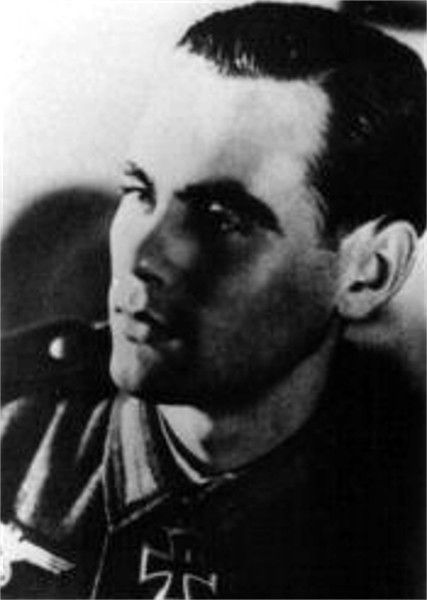Clemente, Ernst (Gebirgsjäger-Regiment 13)
- Date of birth:
- April 27th, 1922 (Freilassing/Bavaria, Germany)
- Date of death:
- January 19th, 1991 (Freilassing/Bavaria, Germany)
- Nationality:
- German
Biography
05.01.1941-13.10.1941: Reichsarbeitsdienst, Belgium and France
17.10.1941: Gebirgs-Panzerjäger-Ersatz-Kompanie 1, Füssen
00.05.1942-00.07.1942: Reserve-Offiziers-Anwärter-Lehrgang, then Hochgebirgs-Ausbildung, Mittenwald
21.08.1942: II. Bataillon, Gebirgsjäger-Ersatz-Bataillon 98, Garmisch
16.09.1942: 16. (Panzerjäger-) Kompanie, Gebirgsjäger-Regiment 13
23.12.1942: promoted to Gefreiter
01.11.1943: promoted to Obergefreiter der Reserve
00.09.1944: distinguished himself during the fightings in Cekles-Zipfel, Romania as Geschützführer, 7,5-cm Pak - broke a Soviet tank attack at Csiksereda
03.07.1944: WIA
29.03.1945: Gebirgs-Panzerjäger-Ersatz- und Ausbildungs-Kompanie 1, Sonthofen
00.03.1945: promoted to Fahnenjunker-Oberjäger der Reserve
00.04.1945: sent to the Kriegsschule, but captured in Tirol - US POW
00.06.1945: released
Do you have more information about this person? Inform us!
- Period:
- Second World War (1939-1945)
- Period:
- Second World War (1939-1945)
- Awarded on:
- January 22nd, 1944
- Period:
- Second World War (1939-1945)
- Awarded on:
- July 5th, 1944
- Period:
- Second World War (1939-1945)
- Awarded on:
- August 10th, 1944
- Period:
- Second World War (1939-1945)
- Rank:
- Obergefreiter (Corporal)
- Unit:
- Pakschütze 1, 16. Kompanie, III. Bataillon, Gebirgsjäger-Regiment 13, 4. Gebirgs-Division, Heer
- Awarded on:
- September 30th, 1944
“It was September 1944 in Hungary. The retreat movements had begun and had led to the now Romanian Cekles Tip. The newly constituted 7.5 cm Pak gun crew consisted of three old and experienced Obergefreiten, namely Clemente, Linner and Knobloch. Clemente was the rifleman no. 1.
On the 11.09.1944 a bridgehead was created near Csiksereda with 2 Bataillonen and an Artillerie-Abteilung, and this was to be held until 20:00 in the evening. The 16. Kompanie had detached a Zug in support of this position. 2 cannons from this Zug were deployed to the frontline, while the gun of Clemente was positioned as a reserve about 100 metres to the left of the only retreat bridge. Another 7-8 Pak guns from a Heer Panzerjäger-Abteilung took up positions in the frontline. At around 18:00 combat noises from the city’s edge became steadily louder.
Suddenly several Russian tanks thrust from the city’s edge along the dusty road in the direction of the bridge. The distance was about 600 metres. Kompanie commander Leutnant Strasser cried out that enemy tanks were breaking through, and in response Clemente went towards the road with the gun. Clemente set up the telescopic sight and turned the barrel in the right direction. No more time was available for digging in as the first T-34 had already approached to within 200 metres. Within seconds the gun was ready, and the first shot soon smashed into the first enemy tank. A cloud of dust enveloped the cannon, and this had barely cleared when the second shot cleared the gun and struck the second tank. The third T-34 was also brought to a halt, almost as if it was at the Steingaden firing range. But - luck and glass, how easily it breaks!
The Russian tanks now stood so close to the telegraph posts on the city’s edge that the gun no longer had a clear line of sight. To make matters worse the fourth shot did not fire. Was it a jam or a late starter? According to the HDV they had to wait a minute, however 12 tanks had opened fire against the cannon. Tank rounds struck before and behind, to the right and left. Clemente gave the rifleman no. 2 the order to immediately remove the round from the barrel. Thankfully the round did not explode in his arms as he took it out. Anxious minutes passed before the man came out of the trench 50 metres behind the gun, where he had laid the round. The next round disabled the fourth enemy tank, this time it was an American Sherman. The fifth enemy tank, this one about 50 metres away, received three direct hits. However all of these rounds bounced off. It suddenly turned around to get a better field of fire. Clemente used this opportunity to strike it in the sides. It was an IS-2!
After this it barely took 10 seconds for the remaining tanks to disappear into the city. They had clearly seen that they would not break through towards the bridge in that way. They had overestimated the firepower of Clemente’s gun, interpreting the quick succession of shots as the efforts of several cannons. Luckily for Clemente the enormous cloud of dust created with every shot made it difficult for the enemy to pinpoint his position.
The gun crew had handled the 10-12 available rounds with great care during the firefight, which was over in only a few minutes. This situation was alleviated by an Artillerie Major. He had observed the battle from not too far off and brought a sizeable ammunition resupply behind the house. Clemente used these to completely destroy the enemy tanks that had not burned out in order to prevent their recovery during the night. Through this deed he frustrated the aim of the enemy armoured wedge to thrust along the retreat road of the Division and block it. With this a breakthrough was averted, and all the remaining friendly units in the bridgehead were able to pull back with all their heavy weapons in an orderly fashion.”
- Period:
- Second World War (1939-1945)
- Awarded on:
- February 10th, 1945
Sources
- Photo 1: Willi Schumacher Collection
- - FELLGIEBEL, W.P., Elite of theThird Reich, Helion & Company Limited, Solihull, 2003.
- HUß, JüRGEN & SONDERMANN, HEINZ-WERNER, Ritterkreuzträger im Mannschaftsstand 1941-1945, VDM Heinz Nickel, Zweibrücken, 2009.
- THOMAS, FRANZ & WEGMANN, GüNTER, Die Ritterkreuzträger der Deutschen Wehrmacht 1939-1945.







